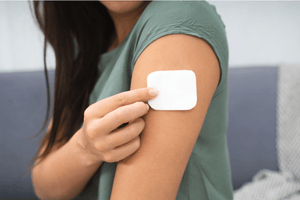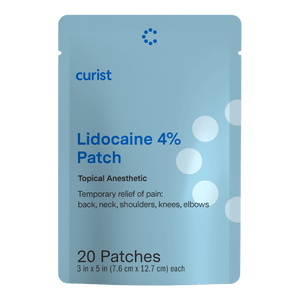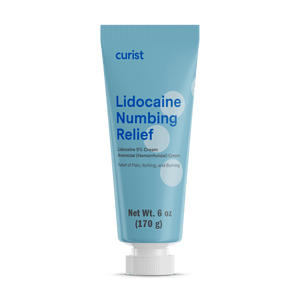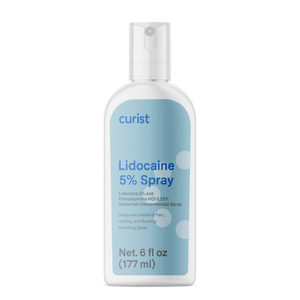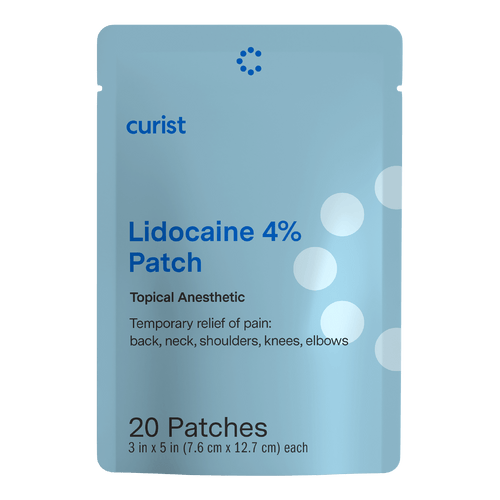Curist delivers over-the-counter medicines to your door at a fraction of the price of traditional brands. We hope everyone stays safe and healthy during this time.
Having trouble deciding between the lidocaine patch or lidocaine cream? In this article, we compare the two different formulations to help determine the best product for you!
How does Lidocaine Work?
Lidocaine is an anesthetic that numbs pain by blocking nerve conduction and interrupting the transmission of pain signals. It does so by reversibly blocking voltage-gated sodium channels and inhibiting sodium influx, which is necessary for initiating nerve impulses. Topical versions of lidocaine permeate through the skin to provide direct pain relief at the site of application. Many topical lidocaine products exist over-the-counter (OTC), and depending on the strength are used to treat backaches, muscle soreness, mild joint pain, itching, nerve pain, and hemorrhoid irritation.
What are the Key Differences between Lidocaine Patch versus Lidocaine Cream?
Although both the lidocaine cream and patch relieve pain at the site of application, there are some key differences between lidocaine patches versus lidocaine creams that may make one preferred over the other.
Lidocaine patches are applied onto the skin and are meant to adhere to the site of pain. They can be used for up to 8-12 hours per application (depending on the specific product) or up to 3 times daily. Lidocaine patches may be a better option if you find creams too messy to use.
Lidocaine creams are applied by rubbing the product into the site of pain, and it is recommended to keep your hands covered or to wash them thoroughly after each application. Generally, lidocaine cream works within 30 minutes and may last for up to 3 hours. Please note that lidocaine at the 5% strength should only be used for anorectal or hemorrhoidal use, while lidocaine at the 4% strength can also be used for topical use on the body.
Depending on the strength, both the lidocaine patch and lidocaine cream (when at a 4% or lower strength) can be used to treat backaches, muscle soreness, mild joint pain, itching, and nerve pain. However, lidocaine creams have the added benefit of being able to treat hemorrhoidal/anorectal pain and irritation.
Is Lidocaine Patch Stronger than Lidocaine Cream? Is Lidocaine Cream Stronger than Lidocaine Patch?
Both the lidocaine patch and lidocaine cream have comparable strengths and analgesic (pain-relieving) effects, low systemic exposure, and are generally well-tolerated. For long-lasting pain relief, lidocaine patches are the best option, as they have sustained effects for up to 12 hours. Lidocaine cream (at 5% strength) is the best lidocaine for burning, itching, irritation from hemorrhoids and anorectal conditions. Please note that lidocaine at the 5% strength should only be used for anorectal or hemorrhoidal use, while lidocaine at the 4% strength can also be used for topical use on the body.
Can I Use Lidocaine Patch and Lidocaine Cream Together?
It is not recommended to use lidocaine cream and patches together. Although topical lidocaine is generally well-tolerated, the risk of adverse effects increases when using both lidocaine patches and lidocaine creams. Using lidocaine patch and lidocaine cream together may lead to higher exposure to the active ingredient beyond what is recommended. Please discuss with your medical provider if you are not getting the relief you would like from using lidocaine.
Who Should NOT Use Lidocaine? Is Lidocaine Safe to Use?
You should NOT use lidocaine if you have a known hypersensitivity to lidocaine or amide local anesthetics (prilocaine, bupivacaine, ropivacaine, etc.).
Use caution and consult your physician for proper use and monitoring for using lidocaine if you have:
- A history of heart arrhythmias and/or are taking antiarrhythmic medications
- A history of methemoglobinemia
- Decreased liver function
Topical lidocaine is safe to use and generally well-tolerated. The most common side effect of topical lidocaine is mild irritation at the site of application. However, some people may experience adverse effects that are often dose-related and include dizziness, nausea, confusion, convulsions, trouble breathing, and cardiac arrest. Please note that lidocaine at the 5% strength should only be used for anorectal or hemorrhoidal use, while lidocaine at the 4% strength can also be used for topical use on the body.
Lidocaine patch and lidocaine cream should not be used on skin that is broken, infected, swollen, or covered with rash. Applying topical lidocaine on broken or inflamed skin may lead to increased absorption of the product and higher systemic exposure, increasing the risk of adverse effects.
Where Can I Buy Lidocaine Patches and Lidocaine Cream Online?
Lidocaine patch and lidocaine cream are available in local pharmacies as well as stores online like Curist, and do not need a prescription.
At Curist, we develop more affordable products to provide the relief but at a fraction of the price of big brands. Curist products are sold online and shipped directly to your door. To learn more:


